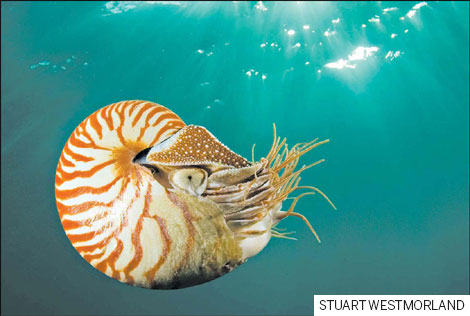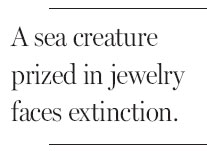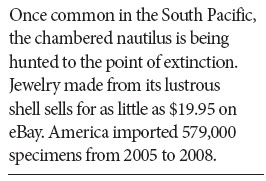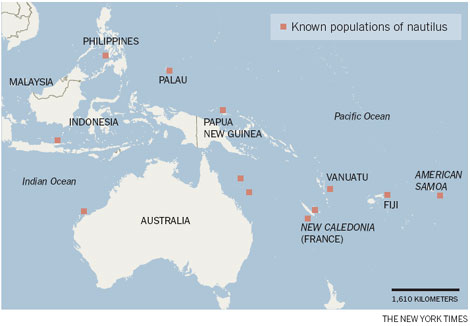Nautilus's beauty could be its ruin
Updated: 2011-11-06 07:43
By William J. Broad(The New York Times)
|
|||||||

Naturalists have long marveled at the shell of the chambered nautilus. The logarithmic spiral echoes the curved arms of hurricanes and distant galaxies. In Italy, the Medicis turned the pearly shells into ornate ornaments.
Now, scientists say, humans are loving the living fossil to death.
"A horrendous slaughter is going on out here," said Peter D. Ward, a biologist from the University of Washington, during a recent census of the marine creature in the Philippines.
The culprit? Growing global sales of jewelry and ornaments derived from the lustrous shell. Fishermen are killing the nautilus by the millions, scientists fear. On eBay and elsewhere, small shells sell as earrings for $19.95. Big ones - the size of dinner plates - go for $56, often bisected to display the elegant chambers.
Catching the nautilus is largely unregulated; fishermen from poor South Pacific countries gladly accept $1 per shell.

"In certain areas, it's threatened with extermination," said Neil H. Landman, a biologist and paleontologist at the American Museum of Natural History in New York.
Scientists worry that rising demand may end up eradicating an animal that grows slowly and needs 15 years or more to reach sexual maturity.
It lives on deep coral reefs in the warm southwestern Pacific. While it is easy to catch with traps on long lines, the depths - as much as 610 meters, below the range of sunlight and scuba divers - make it hard to study. Last summer, biologists began a formal census in at least six regions known to harbor the shy creatures. Dr. Landman said scientists must overcome "a tremendous lack of knowledge" about its numbers and geographic range.
The fossil record dates the nautilus's ancestors to the late Cambrian period, 500 million years ago.
Some were true sea monsters, with gargantuan shells. Over eons, the thousands of species have dwindled to a handful.
The word "nautilus" comes from the Greek for boat. When the first shells arrived in Renaissance Europe, stunned collectors saw the perfect spirals as reflecting the larger order of the universe.
The nautilus erects barriers inside its shell as it grows, leaving unoccupied chambers behind. Like a submarine, it changes the amount of gas in the empty spaces to adjust its buoyancy. And it uses jet propulsion to swim.
To feed on fish and shrimp, it has up to 90 small tentacles - and, like all cephalopods, it has a relatively large brain and eyes. It cannot go too deep lest its shell implode - also like a submarine.
Deceptive marketing may obscure the threat to the nautilus. The opalescent material in the shell is sold as a cheaper alternative to pearls.
It is machined into pleasing shapes and sold as "Osmena pearl." (In the Philippines the Osmena family is a political dynasty; its name lends cachet.)
A recent Web ad offers an "Osmena Pearl Sterling Silver Necklace" for $495. Collectors talk of rare "Nautilus pearls" that sell for thousands of dollars each. Scientists dismiss them as fraudulent.

Biologists have slowly compiled anecdotal reports of population declines near the Philippines, Indonesia and New Caledonia.
But at a conference last year in Dijon, France, Patricia S. De Angelis of the United States Fish and Wildlife Service reported that America had imported 579,000 specimens from 2005 to 2008.
"The figure shocked the hell out of me," Dr. Ward recalled.
Suddenly, a species thought to be fairly plentiful became the object of serious concern. This summer, the Fish and Wildlife Service paid for Dr. Ward's team to begin a global census off the Philippine island of Bohol, which figures prominently in the shell trade.
In August, he said the team was setting 40 traps a day but was catching (and releasing) two creatures at most - a tenth to a hundredth the rate of a decade ago. "A horror show," he called it.
He suspected one particular kind of nautilus "is already extinct in the Philippines" or nearly so.
The team plans to expand the census in December to Australia's Great Barrier Reef. Marine biologists are lobbying for protection of the nautilus under the same United Nations rules that protect the American black bear, the African gray parrot, the green iguana and thousands of other creatures. The rules allow commercial trade if it is legal and sustainable.
Dr. De Angelis described the nautilus team's goals as getting to the bottom of the population question and coming up with a credible estimate for the dimensions of the global trade.
"Ultimately," she said, "we're looking at whether this is sustainable."
The New York Times

(China Daily 11/06/2011 page11)